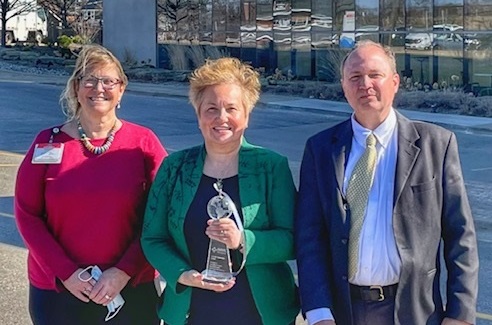The Alliance of Independent Academic Medical Centers has awarded Wayne State University and Ascension Providence Rochester Hospital the 2021 Innovation Alliance Award for an ongoing project that boosts resident wellness.

The award is given annually to an institutional member that best exemplifies creative and innovative approaches to medical education and research.
The award was presented for the wellness initiative described in a poster and paper, “Building a Culture of Well-Being in Primary Care Residency Programs,” written by immediate past-Senior Associate Dean of Graduate Medical Education and Professor of Family Medicine and Public Health Sciences Tsveti Markova, M.D.; Director of Education R. Brent Stansfield, Ph.D.; and Research Coordinator Heidi Kenaga, Ph.D. It was published in the March issue of the Ochsner Journal.
The initiative was launched in 2017 to pursue a sustainable culture of wellness driven by engaged and empowered residents and faculty at three primary care programs -- Family Medicine, Internal Medicine and Transitional Year -- at Ascension Providence Rochester Hospital, an AIAMC member institution.
The program is now being implemented in all of WSU’s sole-sponsored residency programs.
“This award recognizes the hard work of our residents, faculty and staff to integrate wellness initiatives into all facets of our residency training, and we couldn't be prouder of everyone who participated,” Dr. Stansfield said. “Our goal was to create a culture of wellness and avoid what I call the ‘pizza party problem.’ We wanted to ensure that wellness did not become a synonym for fun or time off. It is easy to hold a pizza party and check the wellness box on your to-do list. That’s an inadequate solution to the problems that drive the high rates of burnout and depression we see in physicians and residents. Lack of pizza isn’t the problem.”
A culture of wellness involves creating communication channels between residents, faculty and program leadership, and normalizing communication about self-care, social connectedness, respect in the workplace and professional development, he added.
“I am particularly proud of this award not only because it addresses an important national issue of health care providers’ well-being, but it is a testament of the fruitful collaboration between WSU and APRH. We are one of the two organizations nationwide that have been able to receive the award twice,” Dr. Markova said. “It reflects our commitment to resident wellness and is a result of the design and implementation of an institution-wide initiative on the area over the last three years.”
The project evolved in year one before settling into its current structure. Wellness committees meet regularly to allow residents and faculty to collaborate on initiatives. Each committee sends a representative to the Program Evaluation Committee meetings to put wellness concerns in front of leadership. The Office of Graduate Medical Education spreads the word about institutional resources such as the Employee Assistance Program and Wellness Warriors, and national resources such as the Suicide Prevention Hotline and programs available through the Accreditation Council of Graduate Medical Education, such as free access to meditation apps for health care workers.
“Results from this structure were swift and effective,” Dr. Stansfield said.
In some programs, residents started a steps challenge, competing for highest pedometer step counts.
“This quickly became an ongoing self-care and social connectedness activity. Attending physicians joined in. This activity is still going on, and participants love it,” he said.
Another program created a Wellness Library with books, games and puzzles to provide residents with activities during breaks or downtime between duties.
Programs also hold regular events to engage residents in activities either on-site or off, including 10-minute massage stations, introductory yoga sessions and even a “puppies and ice cream” event in partnership with a local animal shelter.
The initiative also addressed resident concerns about workplace issues, such as providing water-coolers in breakrooms, new mattresses for call rooms where residents nap during long shifts and healthy snacks in breakrooms.
“These initiatives have trickled up into the higher levels of well-being. By empowering residents through the wellness committees, we have seen programs address issues of professionalism more vigorously. Formal professional curricula have been adopted at all APRH programs. These curricula have raised the level of cooperation and inclusion among residents and faculty to improve equity, real and perceived, in scheduling, time off and burden sharing in clinic,” Dr. Stansfield added.
To cap a project inspired by the AIAMC’s national initiative focus in 2019, the Resident Council held a Professional Development Symposium with the theme of Wellness. Regional leaders in wellness held a discussion panel with Wayne State resident leader Danielle Fabry, M.D., about ways to stave off burnout and depression and improve well-being in residency training.
The project also involved the Resident Wellness Scale, designed by WSU to measure resident well-being, using positively-worded items and a behavioral frequency response format. The team partnered with Lloma Linda University and held sessions with residents, faculty and residency administrators with expertise in psychology.
“We asked these experts to name things that ‘well’ residents do or think that ‘unwell’ ones do not,” Dr. Stansfield said. “We converted this list into over 100 items and gave this long survey to volunteer residents alongside measures of depression, burnout, life satisfaction and others. Using these data, we identified 10 items that asked about the most important things on the list and that were also related to the other measures we included. These 10 items serve as our Resident Wellness Scale.”
The Resident Wellness Scale is now used by at least 10 other institutions, including Beaumont Health system, Dr. Markova said. The Accreditation Council for Graduate Medical Education adopted the tool for its annual resident survey, which goes to all residency programs. It is available for free at gme.wayne.edu/wellness/RWSFAQ.html. The scale is hosted on a WSU server, partnered with several institutions through a data-sharing agreement to analyze responses and improve the tool.
“We have collected more than a thousand responses and are learning more about resident wellness every day,” Dr. Stansfield said.